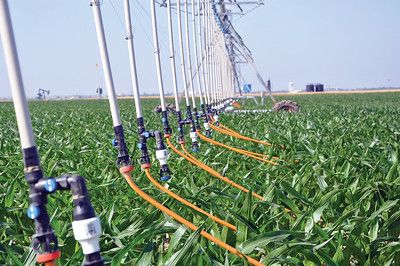5 Regenerative Agriculture Practices Explained
Regenerative agriculture practices are; composting, conservation tillage, crop-livestock integration, cover cropping, and crop rotation.
This article discusses regenerative agriculture practices, as follows;
1). Composting (as one of the Regenerative Agriculture Practices)
Composting is simply the accumulation and controlled biodegradation of organic biomass, for the purpose of producing compost, which is used as a fertilizer for soil.
The benefits of composting as a regenerative agricultural practice are numerous.
Firstly, composting is a means whereby organic waste can be conserved and converted to useful materials.
When agricultural waste is used to make compost, the amount of greenhouse gases like carbon dioxide and methane, that is released into the atmosphere through open-biodegradation, is reduced.
Also, the use of compost as an organic fertilizer for soil, helps enhance important processes like carbon sequestration [3], which is helpful in reducing climate change rates.
Nutrients supplied to soil from compost, reduce the need for chemical fertilizer that can have hazardous environmental impacts.
Composting is seen as a regenerative agricultural practice because it mimics the manner in which soil fertility is improved in natural ecosystems like grasslands and forests, through the accumulation of biomass on soil.

2). Conservation Tillage
Conservation tillage (or reduced tillage) is a sustainable agricultural practice that involves minimizing the rate and intensity with which agricultural land is tilled, in order to maintain soil structure and boost fertility.
While conservation tillage is practiced in regenerative agriculture, there is a notable difference between regenerative agriculture and conservation agriculture (which itself encompasses conservation tillage).
The difference between regenerative agriculture and conservation agriculture is that conservation agriculture aims to mitigate resource depletion on the farm while regenerative agriculture aims to achieve natural regeneration of resources.
In regenerative agriculture, conservation tillage enables the farmer to mimic natural ecosystems, where soil mechanical disturbance is very minimal. The approach helps increase soil organic carbon through improved carbon sequestration rates and biomass accumulation, while preserving soil structure, moisture retention, and overall fertility [2].
It is also highly recommendable in areas prone to hazards like erosion that degrade the soil.
3). Crop-livestock Integration (as one of the Regenerative Agriculture Practices)
Integration of crops and livestock is simply the act and process of combining plant and animal farming in such a manner that treats both organic groups as co-habiting biotic components of a singular, unified ecosystem.
It may alternatively be described as the growth of crops and livestock based on synergies between the growth-cycles and requirements of both groups [4].
In regenerative agriculture, crop-livestock integration helps to establish nature-like conditions on the farm, with functional interdependence between the crops and livestock, which can increase ecological resilience in the long term, while reducing the risk of problems like overgrazing and weed-overgrowth.

4). Cover Cropping
Cover cropping is simply the cultivation of a group of plants known as cover crops on agricultural land, for the purpose of soil conservation and enhancement [1].
In regenerative farming, cover crops are tools for increasing the ecologic resilience of soil, by reducing the effect of environmental factors like physicochemical and biochemical conditions; and erosive agents like wind and water.
While cover cropping is a typical regenerative practice, there are differences between cover cropping and regenerative agriculture.
The difference between cover cropping and regenerative agriculture is mainly in terms of scope; where regenerative agriculture is a broader concept and encompasses cover cropping, among others.
Benefits of cover cropping as a regenerative agricultural practice include biodiversity increase, soil protection, and improvement of fertility and carbon sequestration rates.
5). Crop Rotation (as one of the Regenerative Agriculture Practices)
Crop rotation affects sustainability of agriculture in a positive manner, as it involves the sequential alternation of crop species that are grown on agricultural land.
In regenerative agriculture, crop rotation enables farmers to replicate the process of natural seasonality and succession of species, which is a means by which biodiversity is increased.
Aside increasing biodiversity, crop rotation is useful for soil restoration, protection and conservation; because it mitigates the risk of nutrient depletion as a result of continuous cultivation of a single specie.
Conclusion
Regenerative agriculture practices include;
1. Composting
2. Conservation tillage
3. Crop-livestock integration
4. Cover cropping
5. Crop rotation
References
1). González, I. G.; Fernández, C. H.; Gabriel, J. L.; Alonso-Ayuso, M.; Quemada, M. (2018). “Cover crops to mitigate soil degradation and enhance soil functionality in irrigated land.” Geoderma 322:81-88. Available at: https://doi.org/10.1016/j.geoderma.2018.02.024. (Accessed 14 December 2022).
2). Jayaraman, S.; Sahu, M.; Sinha, N. K.; Mohanty, M.; Chaudhary, R. S.; Yadav, B.; Srivastava, L. K.; Hati, K.; Patra, A. K.; Dalal, R. C. (2022). “Conservation Agricultural Practices Impact on Soil Organic Carbon, Soil Aggregation and Greenhouse Gas Emission in a Vertisol.” Agriculture 12(7):1004. Available at: https://doi.org/10.3390/agriculture12071004. (Accessed 14 December 2022).
3). Koplowicz, S. R. (2019). “Utilizing Compost for Carbon Sequestration: A Strategy for Climate Goals and Land Use Management.” Environmental Science. Available at: https://www.semanticscholar.org/paper/Utilizing-Compost-for-Carbon-Sequestration%3A-A-for-Koplowicz/00e6927a8c9a09b5097e249a4de52e13d51b2b9b. (Accessed 14 December 2022).
4). Martin, G.; Moraine, M.; Ryschawy, J.; Magne, M-A.; Asai, M.; Sarthou, J-P.; Duru, M.; Therond, O. (2016). “Crop–livestock integration beyond the farm level: a review.” Agronomy for Sustainable Development 36(53). Available at: https://doi.org/10.1007/s13593-016-0390-x. (Accessed 14 December 2022).




